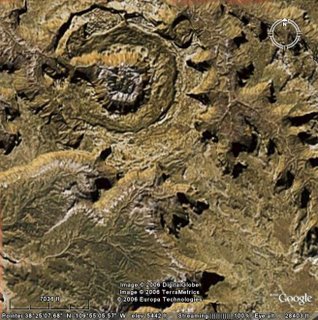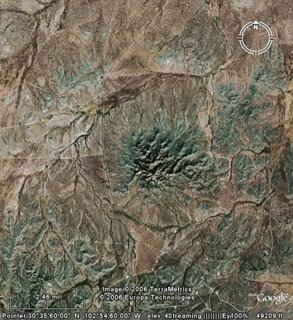 Meteor Crater: One of the best studied and one of the first craters thought to be formed by meteorite impacts is Barringer's Meteor Crater in Arizona, USA. It is a small crater (~1 km in diameter) formed ~50,000 years ago (in the Pleistocene). It's shape is typical for small impactors and is bowl-shaped. The impactor was a metal (iron and nickel) meteorite ~50 m in diameter.
Meteor Crater: One of the best studied and one of the first craters thought to be formed by meteorite impacts is Barringer's Meteor Crater in Arizona, USA. It is a small crater (~1 km in diameter) formed ~50,000 years ago (in the Pleistocene). It's shape is typical for small impactors and is bowl-shaped. The impactor was a metal (iron and nickel) meteorite ~50 m in diameter.Excerpts from Wikipedia:
"In 1903 a mining engineer and businessman named Daniel Moreau Barringer suggested that the crater had been produced by the impact of a large iron-metallic meteorite.
Barringer's arguments [were] met with skepticism, as there was a general reluctance at the time to consider the role of meteorites in terrestrial geology. He persisted nonetheless and sought to bolster his theory by uncovering the remains of the meteorite. At the time of first discovery by Europeans, the surrounding plains were covered with about 30 tons of large oxidized iron chunks from the meteorite. This led Barringer to believe that the bulk of the impactor could still be found under the crater floor. As impact physics were poorly understood at the time, Barringer was unaware that the meteorite had in fact vaporized on impact. He spent 27 years trying to mine the crater and find metallic iron, drilling to a depth of 419 m (1,376 ft), but no significant deposit was ever found."
 Upheaval Dome: located in Canyonlands National Park, Utah, USA. Upheaval dome was originally thought to be a salt upheaval dome but is now known to be the eroded core of a 5-km impact crater. Upheaval Dome was formed in the last 170 million years (Ma). The crater has been subjected to heavy erosion since its formation and is interrupted by stream-eroded canyons. Once 1-2 kilometers of material overlain the now-exposed-but-once-buried impact core.
Upheaval Dome: located in Canyonlands National Park, Utah, USA. Upheaval dome was originally thought to be a salt upheaval dome but is now known to be the eroded core of a 5-km impact crater. Upheaval Dome was formed in the last 170 million years (Ma). The crater has been subjected to heavy erosion since its formation and is interrupted by stream-eroded canyons. Once 1-2 kilometers of material overlain the now-exposed-but-once-buried impact core. Sierra Madre Crater: lies in western Texas, USA. Sierra Madre is a 13-km crater formed in the last 100 million years. It can be recognized as a circular mound of hills (dark green in the Google picture at the left) surrounded by a stream that follows the arch of the crater rim.
Sierra Madre Crater: lies in western Texas, USA. Sierra Madre is a 13-km crater formed in the last 100 million years. It can be recognized as a circular mound of hills (dark green in the Google picture at the left) surrounded by a stream that follows the arch of the crater rim.Some nice impact crater kml files for playing with can be found here: http://www.thinklemon.com/pages/ge/





No comments:
Post a Comment